Helicopters on the fronts of World War II
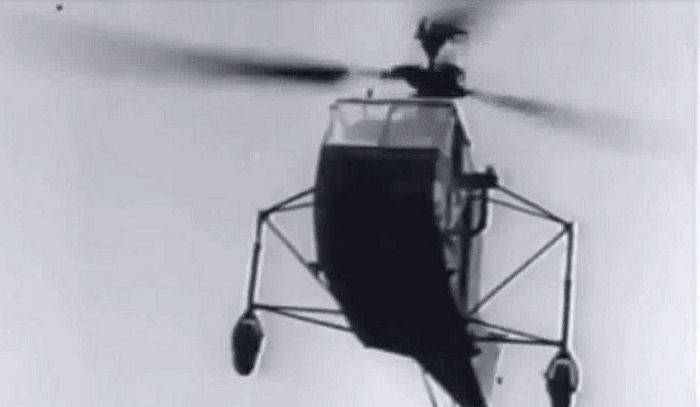
World War II is not associated with helicopters. Meanwhile, it was on its fronts that these machines made their debut as a means of warfare. The debut was not large-scale: the technology of those times did not yet allow helicopters to have a significant impact on the course of hostilities, and they appeared late.
But the first timid experiments of their application turned out to be so promising that immediately after the war this class of technology was awaited simply by explosive development. During World War II, several experimental helicopters were created in several countries. Several of them went into the series. Only a few models managed to see hostilities. And only American helicopters were successful without any reservations.
But the Germans also tried to use their cars in battles, and they are also worth noting.
German helicopters.
Germany was one of two countries that tried to use helicopters in hostilities. The helicopters themselves were not a secret for the Germans: their first rotorcraft flew a few years before World War II. Moreover, the world's first helicopter suitable for any practical application was German. It was a Focke-Wolf Fw 61 that took off in 1936.
In total, during the war years in Germany, many small-scale and experimental machines were created. Some of them were unique, so they tested the ultra-small portable single-seat helicopters Nagler Rolz Nr55 - a folding structure on (exactly “on”, not “in”) which one pilot could sit, over which one blade rotated, balanced by a three-cylinder engine with a small propeller, which by its thrust made the blade rotate.
The machine didn’t fly much, but it lifted 110 kg in hovering.
However, we are interested in cars that saw the war. There were two such cars. The first helicopter from this list was created by a talented German aviation engineer Anton Flettner and entered history like the Flettner FI 282 Kolibri.
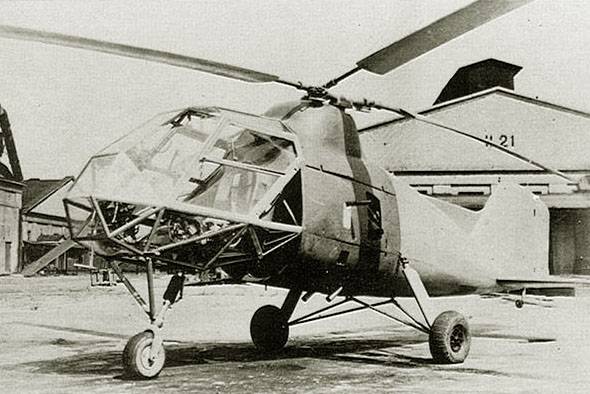
This was not a debut for Flettner, his company had previously built a FI265 helicopter, while the safest helicopter in the world. He was the first helicopter capable of going into autorotation mode and vice versa. After building six helicopters in 1938, used by the Luftwaffe for experimental purposes, Flettner began work on the Hummingbird. All Flettner helicopters were built according to the scheme of a synchroper, or a helicopter with intersecting rotors. After World War II, such helicopters were built and are being built by the American company Kaman. The inventor of such a scheme is precisely Anton Flettner.
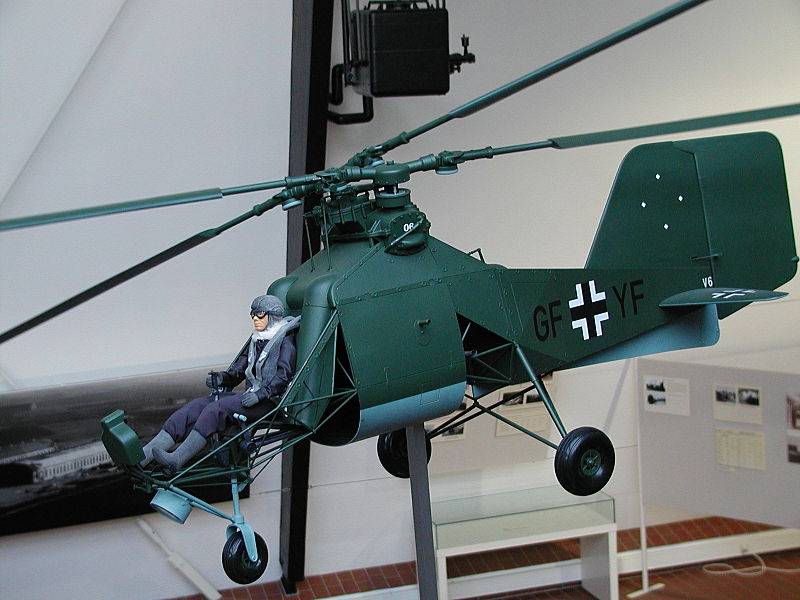
Hummingbird flew for the first time in 1941, fatal for Germany. Soon after the helicopter tests, they became interested in Kriegsmarine. Deprived of Goering’s intrigues of its naval aviation, the fleet was in dire need of reconnaissance equipment.
Since 1941, tests of the machine began in the interests of fleet. What is especially interesting is the attempt to use the car as a deck. A helicopter landing pad was equipped on one of the towers of the Cologne cruiser, from which the aircraft flew over the Baltic.
The experience was recognized as successful, and a small series of helicopters went to airfields off the coast of the Mediterranean and Aegean Seas. By and large, this was a continuation of the tests, although, according to some sources, during the tests, Hummingbirds were used to protect the shipping of the Axis countries from the Allies. If so, then it is worth considering this year as the year of the beginning of the use of helicopters in military operations. However, taking into account the fact that no details of such flights are given, apparently, these were more test flights than sorties for actual combat use.
Over the Aegean Sea
The Luftwaffe, inspired by the successful tests and good aerobatic qualities of the helicopter, ordered a series of thousands of Flettner helicopters from BMW. True, it was planned to use them all over land, as spotters of artillery fire.
By that time, the helicopters had already been modernized, and twice. The first series had a closed pilot's cabin with a glass lantern, the next cars had an open cockpit. Given the low speed of the helicopter (maximum 150 km / h), this was acceptable. Later, an option was created with a second seat in the rear of the helicopter. It was in this form that this machine was supposed to fight on land fronts.
In 1944, a production contract was signed with BMW, and a number of already built Hummingbirds, along with another German helicopter, which will be discussed later, were transferred to the Eastern Front to counter the Red Army units. But soon the BMW plant was destroyed by Allied aircraft, and the plans for the production of helicopters had to put an end to.
It is authentically known that German helicopters made a number of sorties against our troops. All of them were based at a military airfield near the city of Rangsdorf in eastern Germany. But, of course, German helicopters could not somehow influence the course of the war. In the spring of 1945, the last German helicopter was destroyed. Speaking about the reasons for the destruction of helicopters, Western researchers indicate that some of them were shot down by Soviet anti-aircraft fire, and the other shot down by Soviet fighters.
Some modern military-historical resources indicate that the double-seat variants of the Hummingbird were taken out of Gauleiter and a prominent Nazi activist August Hanke, surrounded by Breslau, but this information does not have reliable confirmation. Also, some sources indicate that the Hummingbird performed transport tasks of the 40th Luftwaffe Transport Squadron (Transportstaffel 40).
Only three helicopters survived the war, two of which went to the Americans, and one to the USSR. In the USSR, the helicopter was flown and thoroughly tested, but its design with crossed screws was evaluated as unnecessarily complicated.
Flettner himself and his family left for the USA in 1947, lived there for many years and worked in the American aircraft industry. Flettner was doing well, he was familiar with Werner von Braun, another famous German engineer in the American service. According to some reports, Flettner and his family became the first German emigrants to the United States after the Second World War (not counting those who were forcibly taken out).
Flying Hummingbird. Appreciate maneuverability. Some frames, however, are accelerated
In addition to the Hummingbird, the Germans tried to use another helicopter in the hostilities, the Focke Achgelis Fa.223 Drache (translated as “Dragon”), a heavy machine, much more powerful than the Hummingbird. This helicopter was a little less fortunate and, together with its real participation in hostilities, it participated only in attempts to fight.
The helicopter was designed at the end of the thirties and repeated the scheme of the Focke-Wolf Fw 61, that is, it had two main rotors. It was the largest helicopter in the world at that time. However, the Germans managed to build only 10 cars: the Focke Anghelis factory, on which it was planned to build these helicopters, was destroyed by Allied aircraft in 1942.
The machine made its first flight on August 3, 1940, but this helicopter did not really reach readiness for military service. Work on the project was greatly hindered by the Allied bombing. As a result, the first small-scale Luftwaffe helicopters were only seen in 1943, already at the base of the new aircraft factory, in Laupheim.
During this time, there was a rejection of plans for the production of a whole family of combat and transport helicopters in favor of one multi-purpose modification. However, the new aircraft factory was also soon destroyed by Allied bombers, and a large series of "Dragons" was never built.
A helicopter at that time was outstanding. So, for example, on demonstration flights, the Dragon lifted the Fisler Storch plane or the fuselage of the Messerschmidt Bf.109 fighter on external sling. Moreover, the maneuverability of the helicopter made it possible to accurately deliver the cargo to a truck, trailer or other platform. For such operations, the Germans even developed a self-locking electromechanical hook grip.
Despite problems with production, the Germans tried to use the built prototypes for their intended purpose.
In early 1944, using one of the prototypes built, V11 (all built helicopters had their numbers with the letter V at the beginning), an attempt was made to evacuate the fallen Dornier-217 bomber through the air. At the same time, the helicopter itself crashed. Then, in May 1944, by another helicopter during ten flights, the disassembled plane and helicopter were evacuated on the external sling by another prototype of the Dragon - V14 for 10 flights. It was a success, and the Germans learned a lot during the operation.
After that, two helicopters were sent to the training center of the mountain troops near Innsbruck to participate in experimental exercises with the mountain units of the Wehrmacht. Helicopters made 83 flights, with landings at altitudes of up to 1600 meters troops and light guns were thrown on the external sling. They have proven themselves well.
Then came the turn of the real service. By Hitler’s personal order, a helicopter not yet handed over to the Luftwaffe was sent to Danzig, which by that time was already a front-line city. By that time, the plant had already been bombed and the helicopter test center was deployed at Tempelhof Airport Berlin. From there, a helicopter went to the front, managed by an experienced Luftwaffe helicopter pilot and Helmut Gerstenhauer, a participant in all Draco helicopter operations. The imperfection of the car and the bad weather led to the fact that, having arrived a few days later in Danzig, the Germans had to urgently fly back: the city was already occupied by the Red Army. The return was successful, and the helicopter proved its ability to use a long (12 days) time and fly long distances (1625 km) without regular maintenance at the airport.
After this episode, in January 1945, all the surviving helicopters were sent to the 40th transport squadron, in Mühldorf (Bavaria). The end of the war caught them at the airport in Ainring, where the Americans captured three helicopters. One of them the German pilot managed to destroy before the capture, and he fell to the Americans in an irreparable state. The other two were in good condition.
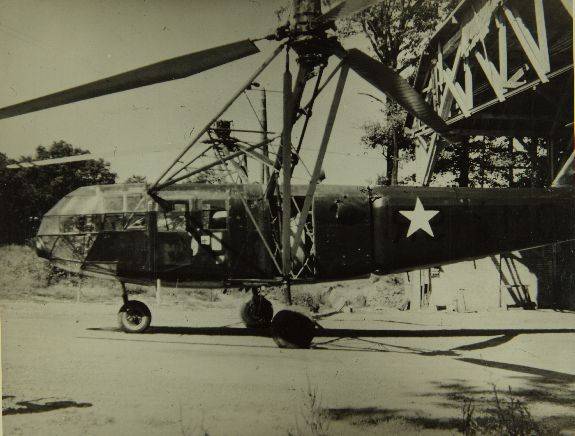
As with the Hummingbird, the Americans circled the Dragons. Then one of them was sent to the United States, and the other transferred to the UK. In order to save time and money, the British decided to fly the helicopter through the English Channel by air, which was done on September 6, 1945 by a prisoner of war at that time Helmut Gerstenhauer. The latter can safely be assigned the title of one of the most experienced German helicopter pilots of World War II, and the Dragon became the first helicopter to fly the English Channel in history.
In the future, the British during the tests ditched this car. But in France, a French helicopter SE-3000 was built at its base, built in the amount of three copies. Cars were used until 1948.
Also, from the captured kits, two helicopters were assembled in Czechoslovakia and served in the Czechoslovak Air Force for some time.
The German attempts, however, cannot be compared with the scale that helicopters used during the Second World War in the USA.
American helicopters and war at sea
As in Germany, in the United States the development of helicopters was very large-scale. Moreover, in the United States, a helicopter with a classic design — the main rotor and tail rotor — immediately got into operation. Our former compatriot Igor Sikorsky created this scheme. He became the father of American helicopter engineering and it was the helicopter that bears his name that made his debut in hostilities on the American side. It makes no sense to list all the experimental and small-series cars that were created in the USA in those years: only the Sikorsky R-4B Hoverfly saw the war. This machine in various modifications became the most massive on the one hand, and the most “combat” on the other, a World War II helicopter.
In addition to the United States, this helicopter entered service with the British Air Force, but he did not see the military service with the British.
In the USA, this machine was used mainly in the US Army Air Force. A number of helicopters received the Navy, and three units - Coast Guard. Military operations were seen only by army helicopters, but it is impossible not to mention two episodes related to non-army helicopters.
The first to recognize the potential of helicopters in a naval warfare in the United States were Coast Guard commanders, mainly its commandant (commander) Russell Washi. In 1942, he approved the U.S. Coast Guard helicopter development program, soon notifying Admiral Ernst King, commander of the U.S. Navy's naval operations, convincing him of the special role of the U.S. Coast Guard in this process. There was nothing surprising in this: the first year of the US participation in the Battle of the Atlantic, the Coast Guard was dragging the protection of convoys from the American side, its contribution in the first months of the war was higher than that of the Navy, shackled by the war with the Japanese. With the filing of Weisha and King, a working group was established on the use of helicopters in anti-submarine defense, which included both naval officers and coast guard officers.
I must say that they managed to predetermine the entire post-war development of shipboard helicopter business.
At the beginning of these glorious deeds, the Coast Guard, having borrowed one Sikorsky from the US Army, organized his flights from a tanker. A little later, the British participating in these tests, tested flights from a specially equipped vessel at home.
The coast guard, however, went further.
After making sure that the helicopters normally fly from the ships, the Bokhr quickly converted the Governor Cobb steam passenger ship into a warship of the same name. Cannons, machine guns were installed on the Cobb, it was armed with depth charges, and behind the chimney there was a take-off and landing platform from which the Sikorsky Coast Guard floats could fly on combat missions.
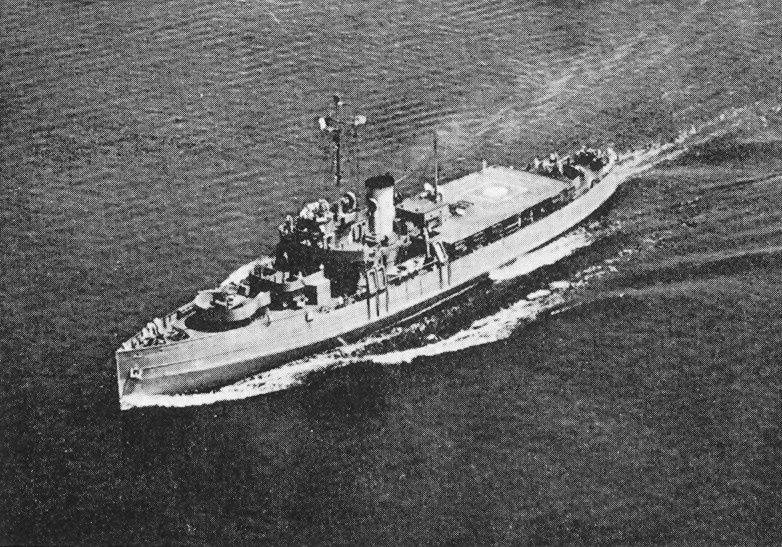
"Governor Cobb" became the first warship in the world armed with helicopters and capable of using them. The Sikorsky helicopters themselves received the name HNS-1 at the Coast Guard and differed from army helicopters only in floats instead of a wheeled chassis.
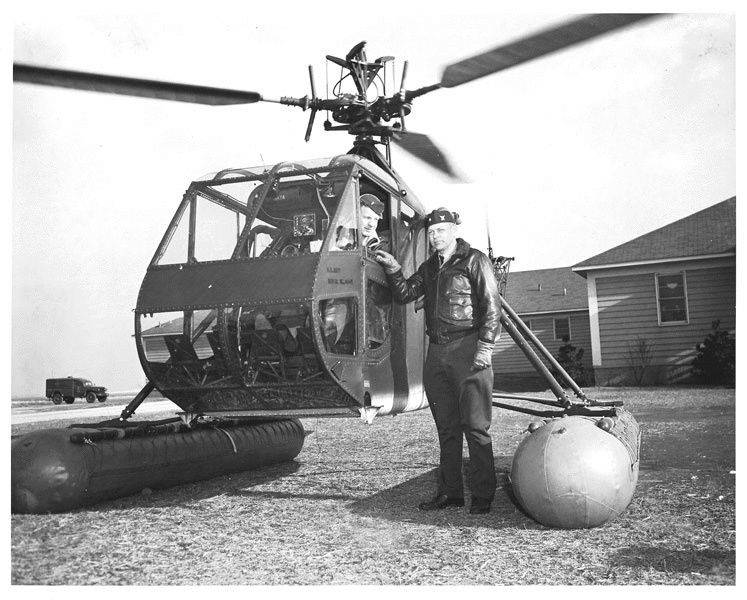
These helicopters did not have to fight, although they took part in the search for German submarines. The Sikorsky’s tests on the Cobb showed that this helicopter was too weak to be an effective submarine hunter: it lacked both payload and range.
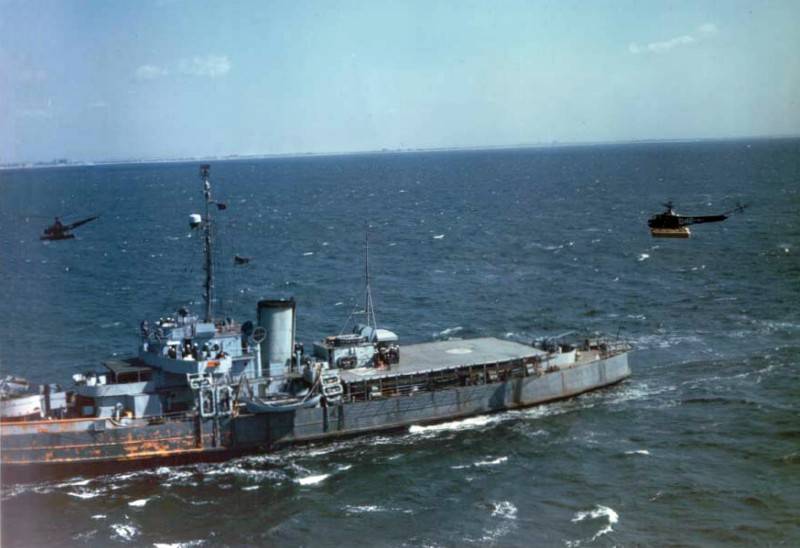
It was after these tests that the Navy significantly reduced the order for helicopters.
Nevertheless, they showed their importance in rescue operations.
Early in the morning of January 2, 1944, right in the harbor of Emborough Light in New York, there was a detonation of ammunition on board the destroyer Turner (USS Turner DD-648). Two hours after the explosion, the ship sank, but a number of sailors were able to leave it and was picked up from the water. Many of them were injured, there were many people with great blood loss.
Survivors were taken to a nearby hospital in Sandy Hook, New Jersey.
But it turned out that there was not enough blood for transfusion. The military had the idea to urgently deliver blood plasma from another hospital by plane, but unfortunately, the wind did not allow the planes to fly. According to journalists of those times, its speed exceeded 25 knots.
The situation was saved by one of the pilot crew of the Bohr, an experienced helicopter pilot, lieutenant commander (lt.commander, the equivalent of our military rank “captain-lieutenant”) Frank Erickson. On his helicopter, he was able to fly into a strong wind, pick up two blood plasma canisters in one of the New York hospitals and deliver them to Sandy Hook in 14 minutes, taking them directly to the hospital, where, of course, no plane would land.
In the rest, the flights of the BOKHR and Navy helicopters were of a semi-experimental nature, and their value mainly boiled down to processing the tactics of using helicopters and gaining experience.
But army helicopters in World War II had to fight for real.
In burma
In 1943, to help the British “Chindites” (special units of the British forces in Burma, operating in the Japanese rear), the Americans formed the “1st Commando Air group, today - the 1st special operations wing.” Her planes waged an air war, including in the interests of Chindith raiders, carrying out air strikes to defend them and to direct them, delivering ammunition and even reinforcements. However, sometimes carrying out the removal of the wounded.
In early 1944, the air group received its first helicopters. Due to the low load capacity, low performance characteristics and insufficient range, it was impossible to use them as combat vehicles.
But they came in handy as a rescue.
On April 22, 1944, Lieutenant Carter Harman, a helicopter pilot of the 1st Air Group, a pilot of the YR-4B helicopter (one of the R-4 modifications), received orders to save the crew and passengers of the crashed aircraft in the jungle. It was not possible to put the plane in place, there was a helicopter. Despite the presence of one seat in the cockpit, Harman succeeded in two days alternately pulling four people into the rear - the pilot and three British soldiers on board. Despite the high altitude and high humidity, which jointly complicated the operation of the engine, Harman managed to take the pilot and soldier to the rear in two flights, packing them in the cabin for two people.
Subsequently, helicopters in Burma and southwestern China were used for similar purposes.
A unique helicopter operation took place in January 1945 in another part of Burma. She deserves to tell you more about her.
Saving Private Ross
On January 23, 1945, an incident occurred at one of the control posts, whose task was to monitor the weather in the interests of American aviation. Private Harold Ross, a 21-year-old New Yorker, accidentally fired a machine gun shot at his own hand. The wound turned out to be harmless, but in the Burmese climate and at the usual checkpoint in the remote mountains of sanitation, the wound immediately began to rot. There was no way to get medical care high in the jungle-covered mountains, it was necessary to go down to the plain, leave the bank of the Chinduin river suitable for subsidence, and there wait for the plane. The speed with which Ross’s arm was swollen unambiguously told his comrades that they would not have time: it took at least ten days to reach his own.
The command initially planned to parachute a medic with medicines, but having assessed the relief, they refused this idea: it was impossible to ensure the safety of a paratrooper's landing in that area.
And then it was decided to use a helicopter at the disposal of the Air Rescue Team.
Ross could well consider himself lucky: the helicopter arrived at the site the day before, it was, upon special request, delivered directly from the United States by air. It is unlikely that anyone would do this for the sake of a 21-year-old stupid infantryman who injured himself, but luck intervened.
Five days before the incident with Ross, an American plane was shot down over the jungle. The crew managed to make an emergency landing, and, despite the wounds, to retreat to the nearest hill and dig in there. It was for the operation to rescue them that required a helicopter. On the 17th, an emergency radiogram from the Eastern Air Command in Burma left for Washington.
On the evening of the same day, at the Wright Field airfield in Dayton, Ohio (now the US Air Force base), the helicopter was already dismantled for loading into a transport aircraft. The operation was commanded by 27-year-old First Lieutenant Paul Shoemaker, a helicopter maintenance and repair engineer.
At the same time, another officer, 29-year-old First Lieutenant Irwin Steiner, a helicopter pilot, was engaged in the selection of rescue equipment that might be needed in a rescue operation. Also captain Frank Peterson, a pilot with more than two years of experience in helicopter flights, a participant in the tests of these machines, was urgently called to the airfield, where the dismantling was carried out. It was for the extremely intensive participation in helicopter tests and the enormous flight experience that Peterson received the captain, despite the fact that he was only 21 years old at that time.
The next morning, the helicopter was dismantled and prepared for transportation. At six in the evening, local time, an S-54 aircraft, which was in the possession of the transport command, arrived at the airfield and helicopter loading began. At 1 hours and 40 minutes on the night of January 19, the S-54 launched to Asia, having on board a disassembled helicopter, a group of technical officers and pilots, spare parts, tools and rescue equipment. The flight through several intermediate airbases took more than two days, and on January 22, at 15.45 Indian time, the S-54 with another crew landed at the base of the 10th Air Army’s Air Rescue Unit in Burma, Myitkyina. The helicopter was immediately unloaded from the plane.
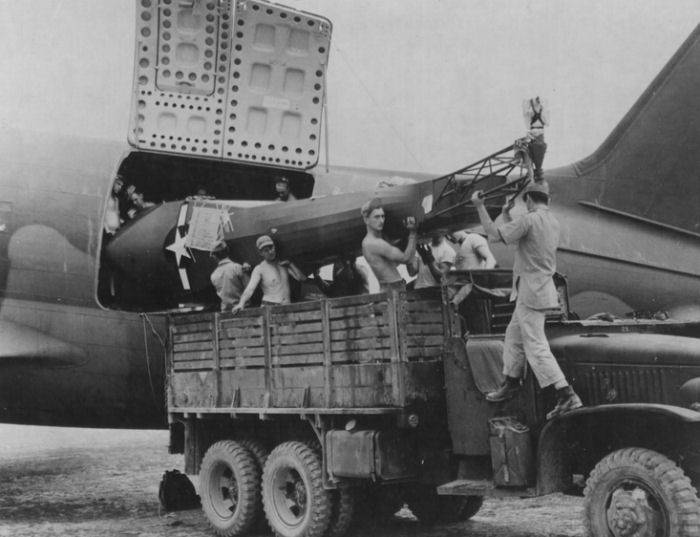
But, fortunately for the downed American pilots and to the disappointment of their rescuers, who were incredibly tired of this expedition, the downed pilots were saved by then: the Americans found a way to get them out of there without a helicopter.
Nevertheless, the command of the rescue squad decided in any case to quickly assemble the helicopter, so that later, if necessary, it would be ready for flights without delay. There was a war, and the reason for the flight was to appear in the very near future.
In the morning of January 23, helicopter assembly began, which basically ended already in the evening, there were minor work and adjustments, and the machine was supposed to reach flight readiness at noon on the 24th.
That day, when the technicians assembled the helicopter, Ross shot himself in the arm. By the 24th, it became clear who the newcomer to the Sikorsky Theater would save first in this war.
There was, however, a problem: the weather observation point from which the wounded soldier had to be removed was too far away, 257 kilometers from the airfield. The helicopter would not have enough fuel to fly. In addition, he was too high in the mountains, at an altitude of more than 1400 meters, and the ability of the machine to get there was under some question, and the helicopter’s ability to fly from there with cargo was even more important. In addition, none of the American helicopter pilots knew the area, and it was impossible to take someone who knew with them: it was necessary to leave free space in the cockpit for the evacuee, the helicopter was double with the ability to somehow shove a third person. To fly to such a range, two pilots were needed, one could not withstand the loads, driving a flimsy machine on the verge of an accident. There was no place for a "guide".
It was also impossible to point the helicopter somehow over the radio, since there was no radio on its board and there was no room for it, no electricity, or, in principle, the possibility of putting it there. All this made the operation incredibly complex. But she, nevertheless, took place.
Thinking, Captain Peterson and Lieutenant Steiner decided to fly.
The plan was as follows. As a guide, two connected L-5 aircraft will fly along with the helicopter. A helicopter, led by airplanes, will fly to the Chinduin River, to the natural "strip" called the Americans Singing Nkatmi, named after one local tribe. On this strip along the river L-5 could sit. The distance from this point to the airfield was 193 kilometers. There L-5 were supposed to bring fuel for helicopters. The pilots were supposed to refuel the helicopter with gasoline and then fly to the pick-up point, where Ross's comrades were supposed to escort him about 96 kilometers from the refueling point.
The helicopter will land there, pick up Ross and try to take off. If it works out, then everything is done in the reverse order. An additional risk was that the part of the territory between the refueling point and the Ross pick-up point was not even properly explored, and there could be anything, including some Japanese detachments. But against the background of other risks, this was already a trifle.
On January 25, 1945, at 8.00:9.00 a.m. training was conducted with the crews of the rescue group, and between 9.15:XNUMX a.m. and XNUMX a.m. the whole group took off.
The problem immediately emerged: the helicopter barely flew in the hot and humid climate of the Burmese highlands, he literally clung the landing gear to the tops of the trees. Speed did not pick up either. But the aircraft did not have any problems with speed gain, but there were problems with how to fly flush with a slow helicopter — the speed with which Sikorsky went in a straight line was less than the speed of stalling slow-moving connected aircraft. As a result, the L-5 revolved around the helicopter, slowly shifting in the right direction.
Then clouds appeared, not very thick, but all together - clouds, the camouflage color of the helicopter and its flight over the tree crowns - led to the fact that the crews of the aircraft lost sight of the helicopter.
But the helicopter pilots guessed about this from the maneuvers of the planes. Steiner, using the gaps in the clouds, signaled to them about his location with a mirror from the emergency set. Several times the helicopter pilots had to take risks flying between the mountains through the clouds, there was no other way, the helicopter could not gain altitude and fly above the clouds or mountains above. The last obstacle on the way was a wide mountain range 1500 meters high. It was impossible to fly around, just fly over. But "Sikorsky" refused. The first, the attempt, the second ... If it does not work out, then sooner or later it will be necessary to return. But on the third attempt, the pilots managed to climb up and cross the ridge. Further, the height of the mountains below sharply decreased. The path to the refueling site was open.
Soon helicopters landed on a sandy strip. To their surprise, they found the crews of three British aircraft there, which were sticking out on the strip for ten days after the emergency landing. The British helped the Americans refuel the helicopter brought to the L-5 with fuel, the Americans shared their rations with them, drank a cup of coffee from the same rations, marking an unexpected meeting, then Steiner switched to L-5 so that it would be easier for Peterson to climb the helicopter to a height and then take off with the wounded. Soon Sikorsky took off again.
Now he had to climb to a height. The path ran between the slopes of the mountains, and the helicopter shook with the wind. In an effort to keep the car from hitting a rock, Peterson worked intensively with “step-gas”, and the engine almost all the time worked in extreme mode. Finally, the helicopter flew to the platform from which it was necessary to pick up Ross - strip on the ledge of the mountain 75 meters long.
After landing, it was found that the consumption of gasoline when climbing into the mountains was such that it would not be enough for the return trip to Singaling Nkatmi. At the same time, neither Peterson nor the soldiers who came to him from the weather station could get in touch with the L-5: the helicopter did not have a radio, the soldiers from the observation post also did not have portable radio stations.
Peterson however managed to show that he needed fuel. After a while, the L-5s were able to drop several packaged cans from a small height and speed.
The helicopter managed to refuel, but a new problem emerged: the oil level in the engine was below normal. This could not be explained by gestures or dances around the helicopter.
But this problem was solved with the help of the local population, who managed to get a light cloth in an amount sufficient to lay out the inscription OIL (oil) on the ground.
Peterson eventually had to spend the night on the mountain. In the morning, L-5 was brought in and dumped also oil. Now it was possible to fly.
Video from the scene. All the defendants fell into the frame, even poor fellow Ross with his idle hand
On the evening of January 26, the stunned Ross was unloaded at Singaling. Into a bunch of Britons and Burmese chasing back and forth. He was in complete shock. He did not know about the existence of helicopters, and on the radio they were told at the post that help was on the way, but they did not say what. His arm was very swollen, but soon the L-5 was already taking him to the hospital. And captain Peterson and Lieutenant Steiner were faced with first night repair of the helicopter, and then a long and dangerous flight over the crowns of trees, between the mountain slopes through the clouds, without radio communications, with increased oil consumption.
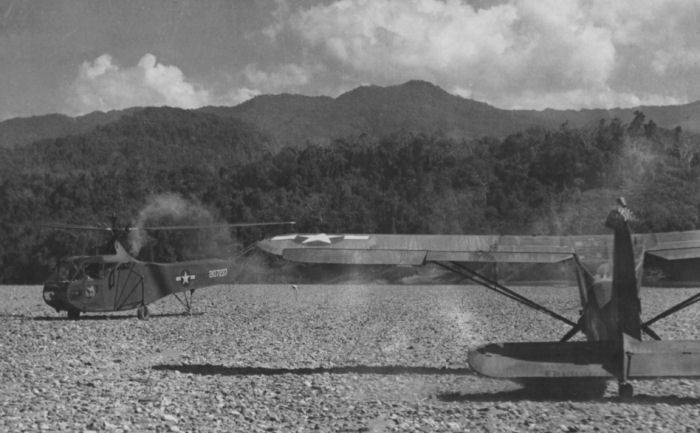
However, there was a pleasant moment: there, on the mountain, the Burmese, who helped Peterson with oil, gave him a spear.
They returned to the base on January 27. From the moment when the eastern command asked for a helicopter to rescue the downed pilots, ten days passed.
In the future, this helicopter and its crew more than once flew to rescue missions. More often, however, not in order to save someone, but in order to remove secret devices from a fallen plane and paint its debris on top with a bright, well-visible paint from the air. Until the end of the war, helicopter pilots had enough work.
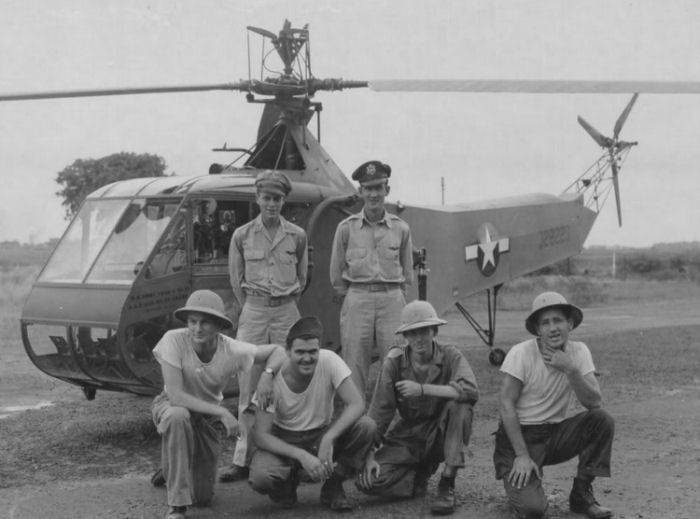
But Burma was not the only place where American helicopters were used in real military operations, although not for solving tasks on the battlefield. They were also used in the Pacific Ocean.
Wounded instead of spare parts
In 1945, the U.S. Army rapidly advanced through the Philippines. There was still more than six months before the victory, and the enemy, although he was badly battered, was not going to give up even close.
Occupying one archipelago after another, Americans regularly encountered difficulties in repairing their combat aircraft. In order to get rid of them once and for all, the so-called “Ivory Soap” project - “Ivory Soap” was launched. Under this name was a program to create an extensive network of floating workshops for repairing aircraft, and of any complexity. Six Liberty-class ships and 18 smaller auxiliary ships, 5000 sailors, aircraft technicians and engineers, a ton of equipment and floating spare parts depots — this armada was to follow the army to immediately cover all aircraft repair needs.
Among other things, the project involved the use of helicopters. At each of Liberty, a landing pad was equipped with which Sikorsky R-4, R-5 and R-6 helicopters were to fly.
They were supposed to be used for the prompt transportation of aircraft components and assemblies for repair and from repairs.
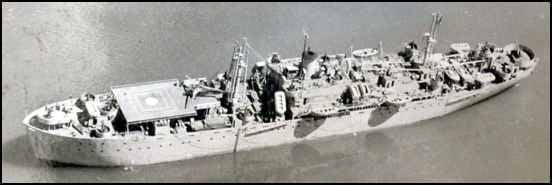
Alas, R-5, R-6 were not ready on time. R-5 did not end up in the war at all. And the load capacity of the R-4 in the single-seat version did not exceed 88 kilograms, which was clearly not enough. Subsequently, helicopters showed that they could carry more, but then it was not obvious.
In June, this fleet of workshop ships, subordinate to the army command, began its mission in the Philippines. At the same time, helicopters were used for their intended purpose: for the urgent delivery of small spare parts from the coast to the floating workshop and vice versa.
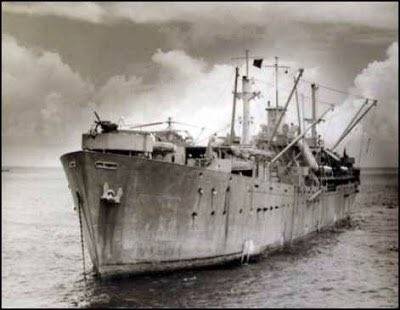
It was during these flights that the commander of the battle group of the 112th cavalry regiment, Lt. Col. Clyde Grant, saw them. He immediately had the idea of how great it would be if these mechanical dragonflies could pull his wounded soldiers out of the jungle.
Grant began to attack the command of the reports with the demand to give commanders on the front line the opportunity to evacuate the wounded by helicopter where the planes cannot land. Grant was refused: it was not clear what the evacuation of the wounded in a helicopter battle was in general, it was not clear whether the helicopter was suitable for this, but it was clear that not one of the helicopter pilots had a medical education and none of them was trained the tactics of using helicopters in the combat zone, if only because then it did not exist.
In the philippines
But Grant insisted. In the end, he managed to break the system. Just ten days after the helicopters arrived in the Philippines, they began to be used to evacuate the wounded from there, from where they could no longer be evacuated.
Since June 26, five lieutenants on their R-4 began to carry out the tasks of evacuating the wounded. A little later, one of the R-4 was replaced by R-6. One of them was Louis Carley. During one of the first flights, Carley, who had no military experience, landed right on the front line, occupied by overgrown and slightly inadequate soldiers, who immediately tried to push a stretcher into the helicopter with their platoon commander. But they did not fit there. The soldiers and Carley were able to dismantle the second seat without a tool from the helicopter and, back to back, still place the stretcher there. The soldiers had no idea about helicopters and were additionally shocked by these machines.
June 21, Carley came under fire. His helicopter was shot down, and he himself received several injuries. The machine made an emergency landing in battle formations of a small American detachment cut off by the Japanese from their own. The helicopter had to be destroyed from the bazooka, and the wounded Carley, along with the infantrymen, went out to his own through the jungle teeming with the Japanese, and even shot one of them with a pistol, facing him point-blank in the thicket.
On the same day, under less dramatic circumstances, an R-6 was shot down. The helicopter pilot was also lucky: he sat down among his own, and without injuries, and was sent to the rear. The helicopter was repairable and was later evacuated.
The combat losses of two helicopters, which were needed for the transportation of spare parts, stopped their evacuation of the wounded. From the end of July 1945 they were no longer carried out. Perhaps this was influenced not only by losses, but also by the complete unpreparedness for such tasks of people and equipment. R-4 was extremely difficult to control: in general, it was technically unable to maintain a stable course and it was necessary to “catch” the entire flight. Vibrations significantly exceeded the level safe for health, and in general, even without getting under fire, flying on these machines was a serious test. In hot and humid climates, in high mountains, helicopters worked "for wear and tear": for normal take-off from wounded on board pilots had to bring the engine to forbidden speeds, and almost always. This did not please those who needed helicopters for their main task. And such a regime did not contribute to the preservation of the pilots “in shape” - the same Carley at the time of the downing was on the verge of nervous exhaustion. Others were no better.
Nevertheless, according to various sources, the helicopter pilots managed to save from 70 to 80 wounded military personnel.
Soon after the events described, the war ended.
* * *
The Second World War gave a ticket to the life of a mass of species weaponswhich we usually associate with later times. Fighter jets, ballistic and cruise missiles, anti-tank guided missiles, anti-aircraft missiles, anti-ship guided and homing ammunition, night vision optics for armored vehicles, radars, including aircraft, friend or foe identification systems in aviation, anti-tank rocket-propelled grenade launchers homing torpedoes, assault rifles under an intermediate cartridge, nuclear weapons - all this was created and first used during the Second World War.
Helicopters are also on this list. Appearing for the first time before the war and at the same time showing their practical feasibility, they were already used during the war itself, just the undeveloped technological level and the presence of a mass of more important tasks for the industry led to the fact that the technical level of helicopters did not allow them to solve complex combat missions.
But they already solved some problems then and solved in such a way that it was clear: before this means there was a bright future.
So in the end it happened. Five years after the end of World War II, during the war in Korea, helicopters were already completely different and used in completely different quantities.
But the beginning of this and all subsequent use of helicopters in wars and in civilian life was laid precisely by the Second World War.
- Alexander Timokhin
- AAF photos National Air & Space Museum, US Army, US Coast Guard, Wikipedia commons
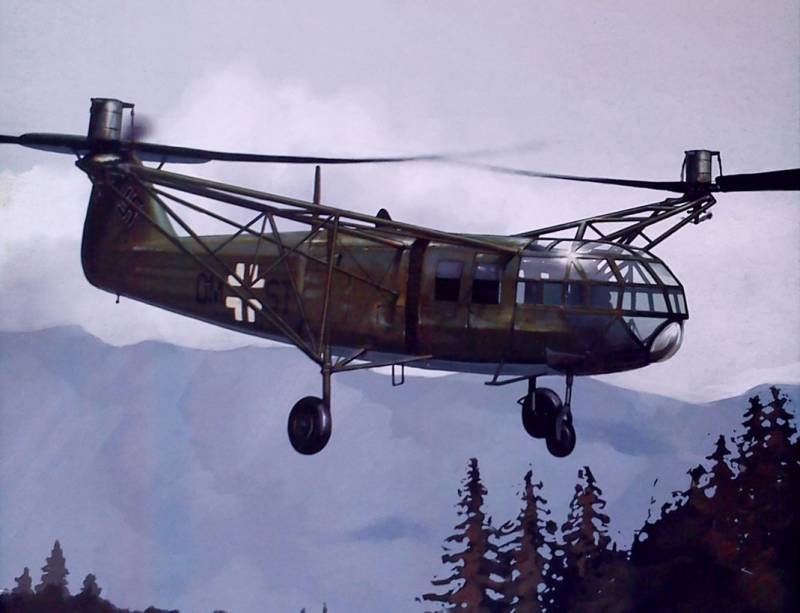
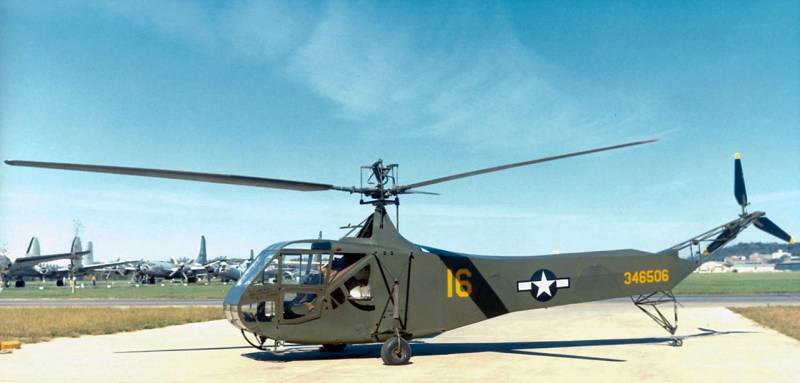
Information